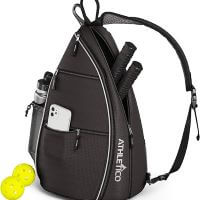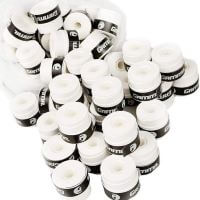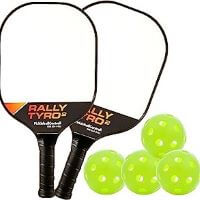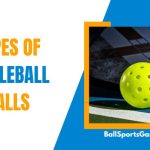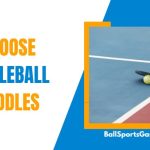If you’re a tennis court owner or player, you may have heard concerns about the impact of pickleball on your beloved courts. Pickleball is gaining popularity as a fun and low-impact sport for all ages, but some are worried that playing it could damage tennis courts. So, does pickleball really pose a threat to your tennis court?
In this blog post, we’ll explore the benefits of pickleball, its impact on tennis courts, and what can be done to ensure both sports can coexist harmoniously. Let’s dive in!
You Might Also Like:
Does Pickleball Damage Tennis Courts?
As the sport of pickleball continues to gain popularity, many people have started to wonder whether it’s causing damage to tennis courts. After all, pickleball is often played on these surfaces, and it involves players hitting a hard ball back and forth across the court.
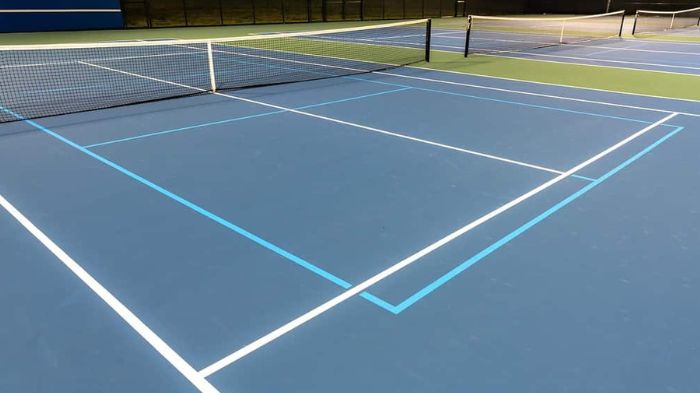
So, what’s the answer? As it turns out, there are a number of factors that come into play when it comes to determining whether pickleball is harmful to tennis courts. So you should know how much does it cost to build a pickleball court. In this article, we’ll explore some of the most important considerations.
The Impact of Non-Marking Shoes
One factor that can affect the extent to which pickleball damages tennis courts is the type of shoes that players wear. Fortunately, many pickleball players opt for non-marking shoes, which are less likely to cause damage than traditional athletic shoes with black soles.
The Importance of Proper Line Installation
Another consideration is the installation of pickleball lines on tennis courts. When these lines are not installed or removed properly, they can cause some wear and tear to the court’s surface. However, with the right installation techniques, the impact can be minimized.
The Effects of Pickleball Balls on Tennis Courts
Finally, the impact of pickleball balls hitting the tennis court can also cause some damage over time. While the damage is usually minimal, it’s important to keep in mind that any repeated impact can lead to marks or scuffs on the surface.
Preventing Damage to Tennis Courts
To prevent any potential damage caused by playing pickleball on a tennis court, it’s recommended that players limit their games to designated areas marked specifically for pickleball. Additionally, ensuring proper installation and removal of lines will help minimize any negative effects on the tennis court’s surface.
The Effects of Pickleball Balls on Tennis Courts
Finally, the impact of pickleball balls hitting the tennis court can also cause some damage over time. While the damage is usually minimal, it’s important to keep in mind that any repeated impact can lead to marks or scuffs on the surface.
Preventing Damage to Tennis Courts
To prevent any potential damage caused by playing pickleball on a tennis court, it’s recommended that players limit their games to designated areas marked specifically for pickleball. Additionally, ensuring proper installation and removal of lines will help minimize any negative effects on the tennis court’s surface.
The Benefits of Proper Line Installation
Proper installation and removal of pickleball lines are crucial to prevent any wear and tear on the tennis court’s surface. By following the right techniques, the impact can be minimized and the court can remain in good condition.
The Effects of Pickleball Balls on Tennis Courts
The repeated impact from pickleball balls hitting the surface of a tennis court can lead to marks or scuffs over time. While the damage is usually minimal, it’s important to be mindful of the potential effects.
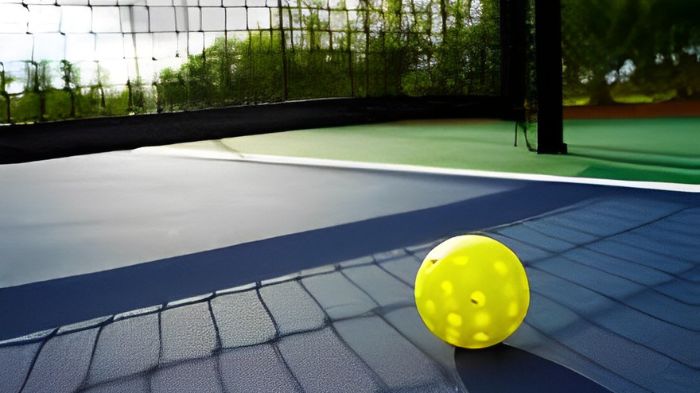
Preventing Damage to Tennis Courts
To ensure the safety of your tennis court, it’s recommended to limit pickleball games to designated areas marked specifically for the sport. By following maintenance guidelines and being mindful of installations, the risk of any damages can be greatly reduced.
While playing pickleball on tennis courts may cause some minor impacts, these can be easily mitigated with proper care and attention. By following the guidelines outlined above, you can continue to enjoy the sport while keeping your tennis court in excellent condition.
How Can Pickleball and Tennis Be Played Together?
- Pickleball and tennis can be played together in a number of ways, making it possible for players to enjoy both sports at the same time. One way is to use the same court for both games by painting different lines on it.
- Players can set up temporary nets for pickleball on one side of the court while using the other half of the court for tennis. This allows players to switch between games with ease and play more than one game without having to move from one location to another.
- Another way is to alternate playing Pickleball and Tennis during certain times or days so that everyone gets a chance to participate in their preferred sport without any conflicts occurring.
- If there are multiple courts available, they can designate some courts specifically for Pickleball and others solely for tennis. This ensures that each sport has its dedicated space, allowing players to fully focus on their respective games.
- Combining these two sports provides ample opportunities for athletes of all ages and skill levels who want variety while still enjoying similar gameplay elements across both disciplines.
Pickleball Lines And the Possible Damage To Tennis Courts
Pickleball is a growing sport that has gained immense popularity globally. However, one of the common concerns among tennis court owners and managers is whether pickleball damages tennis courts.
The answer to this question largely depends on the type of surface used for the tennis court. Most hard-court surfaces are durable enough to withstand the impact and friction caused by pickleball play without any major damage or wear and tear.
However, what’s important to note is that installing permanent pickleball lines on a tennis court can lead to some potential damage over time. During installation, these lines require cutting into the existing surface which can weaken it in certain areas. Over time, regular use of these areas during both sports could result in surface irregularities such as cracks or bumps.
To prevent this kind of damage from occurring, it’s recommended that temporary lines be used when playing Pickleball on Tennis Courts. These types of lines are non-intrusive and won’t cause any long-term structural changes or harm to your tennis court surfaces if placed correctly.
While Pickleball may not necessarily cause significant damage to most tennis courts’ surfaces – it’s still essential for players and court managers alike always prioritize proper maintenance practices like using temporary lines instead!
What’s The Best Surface to Play Pickleball On?
Pickleball is a game that has been gaining popularity in recent years due to its fast-paced and exciting gameplay. But did you know that choosing the right surface to play on can greatly affect your gaming experience? Here’s a breakdown of the most common surfaces used for Pickleball and their advantages and disadvantages.
Concrete: The Popular and Affordable Option
Concrete is a common choice for Pickleball courts because it is durable and affordable. It offers a smoother surface compared to other materials, making it easier to move around on. However, it can become slippery when wet, which can be dangerous during gameplay.
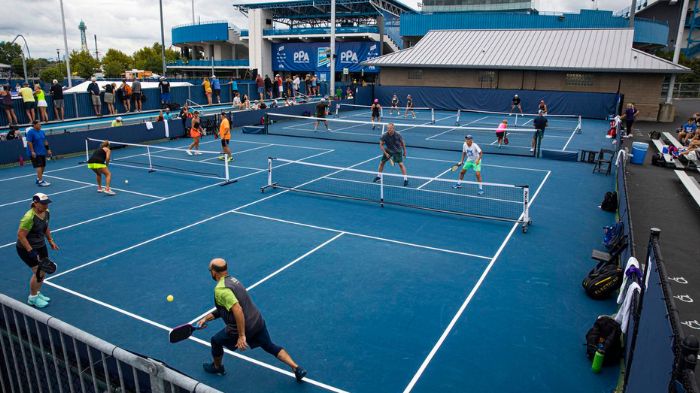
Asphalt: A Smooth Surface but Hard on Joints
Like concrete, asphalt provides a smooth surface that’s easy to play on. But, it can be hard on players’ joints due to its lack of shock absorption. If you’re playing for long hours, this may be a concern.
Tennis Courts: The Ideal Playing Area
Tennis courts are an excellent choice for Pickleball because they offer consistent bounce and traction, making them perfect for competitive play. They’re designed specifically for tennis or Pickleball games with proper dimensions of 20 feet by 44 feet. If you’re looking for a more professional playing experience, tennis courts are the way to go.
Synthetic Turf and Rubberized Flooring:
It is Shock Absorption and Joint Stress Relief. Apart from the standard surfaces, players may opt for synthetic turf or rubberized flooring systems. These options offer better shock absorption, making them ideal for reducing joint stress levels during long hours of gameplay.
Finding the Perfect Pickleball Surface
In the end, choosing the best surface for Pickleball depends on individual preferences. Whether you prefer indoor or outdoor games, fast-paced or slow-paced ones, all factors matter in determining what suits you best. So, pick your surface, grab your paddle, and let the game begin
FAQs
The most common surfaces used for Pickleball are concrete, asphalt, and tennis courts. Concrete is popular because it is durable and affordable, while asphalt offers a smooth surface that’s easy to play on. Tennis courts provide an ideal playing area with consistent bounce and traction, making them perfect for competitive play. Synthetic turf or rubberized flooring systems can also be used for better shock absorption and to decrease joint stress levels during long hours of gameplay.
Yes, Pickleball can be played on a tennis court. In fact, many Pickleball players prefer playing on tennis courts because they provide a more professional playing experience with the proper court dimensions and consistent bounce and traction. However, repeated play on a tennis court can cause some wear and tear to the surface over time.
Yes, Pickleball can be played indoors, but there are some considerations for indoor play. Indoor courts may be smaller than outdoor courts, and the surface may be different, such as a hardwood or vinyl surface. Lighting, ventilation, and temperature control are also important factors to consider for indoor play.
Some pickleball strategies and techniques for playing Pickleball include playing at the net, using dinks and drop shots, and practicing good footwork and positioning. Players can also work on improving their serves, returns, and volleys to become more competitive.
Final Thoughts
Pickleball is a fun and exciting sport that can be played on various surfaces. While it may cause some damage to tennis courts if not properly managed, there are several ways to minimize the impact of Pickleball on these courts.
By using temporary court lines and playing with softer balls, players can enjoy both sports without causing significant damage to the court surface. It’s essential for facilities managers and players alike to take care of their courts so that they remain in good condition for years to come.
Pickleball has many benefits, including improved health and social connections. By taking proper precautions and considering the best surface options for your facility, you can ensure that everyone enjoys these benefits while minimizing any negative impacts on tennis courts. So grab your paddles or rackets and head out onto the court – let’s play!

